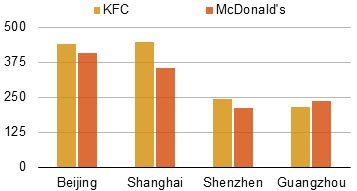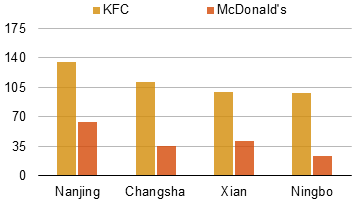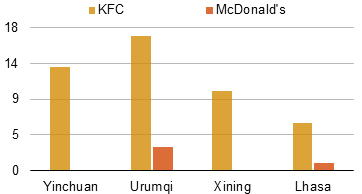1. Introduction
In China, in addition to KFC and McDonald's, there are numerous new Chinese fast food restaurants, such as Mr. Rice, Xiangcun Ji, Real Kung Fu, etc. The new fast food in China is also more in tune with the appetites of the Chinese people; as a result, hundreds of locations have emerged in China in just a few years. However, it is still a long way from multinational chains like KFC and McDonald's. Nevertheless, compared to KFC and McDonald's, KFC has done a significantly better job of "adapting to the local diet and implementing numerous adjustments." This is one of the reasons why KFC has more stores than McDonald's in China [1].
This study will employ three methods of research. First, through comparative analysis, the paper, using actual cases and data analysis to intuitively evaluate the different business strategies of McDonald's and KFC and the difference in data between them, demonstrates why McDonald's turnover in China is not greater than that of KFC. Through the examination of American and Chinese eating patterns, the survey method is used to analyze why KFC and McDonald's must modify their business models and replicate them in China. It also examines what modifications should be done before introducing Chinese fast food to the United States. Thirdly, case research examines the significance of localization by analyzing KFC's menu and business model modifications in China. it was stated that it is crucial to the reference [2].
This study will investigate the distinct business strategies of KFC and McDonald's in China, why KFC has more shops in China than McDonald's, why KFC's revenue in China is more than McDonald's, a nd how to apply this outstanding marketing strategy to Chinese fast food and turn it into a global business. This research is primarily offered to fast food chains. To make these fast food companies more worldwide and expand their store count, there are certain marketing strategies can increase their turnover.
2. Analysis
2.1. Comparison of Marketing between KFC and McDonald’s in China
Although it's true that McDonald's and KFC have long been rivals, from a worldwide perspective, KFC is not a serious threat to McDonald's. Compared to McDonald's more than 30,000 locations, KFC's worldwide footprint is just about a third as high at 11,000 outlets. KFC, on the other hand, is more successful than McDonald's in China, both in terms of revenue and store count. It was mentioned that this is a crucial part of the reference [1].
On November 2, 1987, KFC launched the first location in China. Comparing that to McDonald's first restaurant opening in 1999, you will see how long ago that is. KFC had a specific objective at the time; according to its own publicity materials, the company wanted to become "inseparable from the eating habits of the Chinese people." To achieve this goal, it adopted localization strategies, adapted to Chinese cuisine, and reformulated its products. In any case, the diets of the Chinese and the Western world are drastically different from one another. With the tagline "American fast food can also be extremely Chinese," KFC entered the Chinese market with a universally liked first impression. Because at the time everyone believed that eating western cuisine would be extremely western, but not everyone could adjust to the Western diet, KFC seized this breakthrough and made the so-called "Western food" more acceptable, it also captured the psyche of the Chinese people at the time. And at that time, KFC will become a site where many people go on dates, where youngsters are rewarded for high grades, and where many kids merely want to celebrate their birthdays.
But KFC is more widely consumed than McDonald's. McDonald's continued its global consistency and standardization when it opened in China in 1999. McDonald's, on the other hand, disregarded the significant cultural and historical dietary differences between China and the West. McDonald's beef cheeseburgers never really caught on since so many people either didn't like cheese or didn't know what cheese was. McDonald's failed to match KFC's level of localization, hence its sales volume lagged behind [3].
KFC's entry into the Chinese market has resulted in a boom in franchise opportunities, and the company is now reaping the financial benefits of a large increase in the number of outlets it operates there. Franchisees must buy all ingredients from KFC headquarters, from which KFC can also deduct a portion of the costs, in addition to paying the franchise fee.
But back then, McDonald's was treated more like a straight chain than a franchise. McDonald's own business strategy involves the acquisition of land, but this is not a viable option in China as it is in the United States. McDonald's development rate in China is significantly impacted by the high cost of land in comparison to the United States. This is a result of China's massive population and exceptionally high population density.
McDonald's and KFC are examples of American fast food, the kind of restaurants people go to when they don't have the time or want to cook, and when doing so will negatively impact their budget. The average American hardly ever eats at a table. The majority of fast food is ordered from cars and taken home. KFC and McDonald's were seen as exotic because they were foreign imports at the time in China. Moreover, the prices were not expensive in China, but when McDonald's and KFC entered China, the prices were practically the same as those in the United States, so for the majority of middle class Chinese people, KFC and McDonald's is a substantial dinner, thus you can often find couples or families there. In light of this, many KFC locations now provide a small playground area for kids. Toys, slides, and other kid-friendly attractions will be available. For this reason, KFC's popularity among children skyrocketed. Kids' rewards have evolved throughout time to include trips to McDonald's. However, McDonald's is standing firm.
2.2. Comparison of the Number of KFC and McDonald's Stores in First-tier Cities in China

Figure 1: KFC and McDonald’s store comparison ( in first-tier cities in China).
From the bar chart above we can tell that in first-tier cities in China KFC has more stores than McDonald’s in average.
2.3. Comparison of the Number of KFC and McDonald's Stores in Second-tier Cities in China

Figure 2: KFC and McDonald’s store comparison ( in second-tier cities in China) (original).
From the figure 2, it tell that in second-tier cities in China KFC also has more stores than McDonald’s in average.
2.4. Comparison of the Number of KFC and McDonald's Stores in Third-tier Cities in China

Figure 3: KFC and McDonald’s store comparison ( in third-tier cities in China).
As can be seen from the preceding bar chart, KFC still has, on average, more locations than McDonald's does in China's third-tier cities. Some cities of the third tier don't even have a McDonald's. It was mentioned that this is a significant part of the reference [4].
Thus, it's safe to say that McDonald's almost never enters the market in low-population secondary cities and rarely does so in third-tier locations. McDonald's tends to focus on developing its brand in major metropolitan areas. Many folks in less-populated areas may not be familiar with McDonald's, but they almost certainly have heard of KFC. With this, KFC can rival, and maybe surpass. McDonald's in terms of brand recognition, and perhaps even sway consumers to prefer KFC over McDonald's.
3. Discussion and Analysis of Chinese Fast Food from the Perspective of KFC’s Business Model
There are currently a plethora of Chinese-run fast food franchises including Mr. Rice, Real Kung Fu, Xiangcun Ji, and many more. These quick-service eateries specialize in rice and Chinese cuisine. What these fast food joints and KFC have in common is that they serve customers quickly after they place an order; almost all of the dishes are prepared and only require a simple heating; almost anyone can be qualified for this position; and all of the dishes are uniform in appearance and taste, guaranteeing that production won't vary much from one location to the next.
Some lessons from KFC's success can be applied to the development of China's new fast food in order to make it a global phenomenon on par with the original.
3.1. Franchising
When KFC initially entered China, they conducted extensive market research and introduced Chinese breakfast items like soybean milk fried dough sticks and so on. This was the first step toward making Chinese fast food a global phenomenon. While there are a plethora of Chinese eateries outside, China has hardly any fast food options of its own. Only the panda express is widely known. How, though, can we create a Chinese fast food option that can rival panda express? Is there a secret to Chinese fast food's rapid expansion? Is there a way to make it as competitive as Panda Express?
Based on our findings, we've concluded that Panda Express is better off remaining a corporate-owned business, which eliminates the possibility of a Panda Express franchise. For these Chinese fast food restaurants to quickly expand and gain a foothold in other countries, KFC must employ a franchising approach. It was stressed that it was crucial thatall materials be purchased from the main office in order to guarantee product quality [4].
3.2. Localization Strategy
Just as the Romans did in China, you should follow their example. Once established in China, the American fast food chain KFC expanded its menu to include Chinese breakfast, snail noodles, and many other traditional Chinese dishes. As a result, KFC has decided to discontinue its drive-through service in China. So, before introducing Chinese fast food to foreign nations, it's important to study the local customs thoroughly. If you want to operate a business in the United States, for instance, you should research the state of the Chinese restaurant industry there. Irrespective of how small, it was deemed significant enough to the reference [5].
In the United States, the fortune cookie is a staple at nearly all Chinese restaurants. A fortune cookie is a traditional part of the service at American Chinese restaurants. There will be a slip of paper in the fortune cookie. The tiny scrap of paper within, legend has said, can reveal your future. Contrary to popular belief, fortune cookies do not exist in China [6]. However, Chinese fast food would need some adaptation before it could be successfully launched in the United States. Fortune cookies are a necessary addition to any Chinese takeout or delivery order. Soda is more popular in the United States than soup, thus Chinese fast food joints should think about stocking it.
3.3. Personal Opinion
The author suggests that Chinese fast food restaurants be introduced to the U.S. market in major cities like Los Angeles and New York, where there is already a sizable Chinese community. because more people will want to consume Chinese food if there are more Chinese people, which is why it is important to [7]. So that the meals are first recognized by the Chinese, and subsequently by the Americans through appropriate menu adjustment, it is important that we establish a name for ourselves in the American market as soon as possible. The author thinks most Americans have a sweet tooth, which is why they enjoy the Panda Express menu so much [8]. And that is why Kung pao chicken and sweet and sour pork ribs, for example, need to be sugared up to appeal to American palates. Moreover, the prices may be slightly higher than in China, with a basic combo in China costing about 30 RMB (about $5) on average. A price increase is warranted, however, to account for the higher cost of labor and food transportation in the USA. Personally, the author thinks Panda Express should raise the price of even their most basic combo from $10 to $15.
4. Conclusion
In this paper, the author analyzes the business strategies of both KFC and McDonald's and explains why the former has a better chance of expanding its presence in China and becoming a household name there. The best explanation is the excellent marketing that KFC employs in China and which makes extensive use of local culture. Help the Chinese population swiftly adapt to American fast food. The author thinks that Mr. Rice, Kungfu, and Rural Base, three popular Chinese fast food chains, can learn a lot from KFC on how to become global chains and expand into other markets. Chinese fast food chains can benefit from KFC's success by adopting two strategies—franchising and localization—that will help them swiftly gain recognition in the fast food marketplaces of other nations and expand their operations. It was mentioned that this is a crucial part of the reference [9].
Rather than conducting a statistical analysis of Chinese fast food, the author instead relies on a theoretical approach that is less obvious and more difficult to follow. It is recommended that the author create a chart or run some computations to better illustrate the facts. We may expect future works from this author to be of a higher quality. The author will do an analysis of the data and make the analysis more intuitive using explanation theory.
References
[1]. Jin. “Difference between McDonald's, KFC and Subway.” Research, Scholarships, Funding Agencies, Certifications, 19 Aug. 2020, https://researchpedia.info/difference-between-mcdonalds-kfc-and-subway/.
[2]. Xiao Ping. “Competitors and Companions: KFC and McDonald's in China.” The Global Network for Advanced Management, 1 June 2018. https://globalnetwork.io/perspectives/2017/01/competitors-and-companions-kfc-and-mcdonalds-china.
[3]. “4 Reasons Why Localization Is so Important.” Vnlocalize, 10 Mar. 2021, http://vnlocalize.com/4-reasons-localization-important/.
[4]. “KFC Franchise: Costs, Fees & Earning Stats (2022).” The Wolf of Franchises, 16 June 2022, https://wolfoffranchises.com/kentucky-fried-chicken-franchise-kfc/.
[5]. Shen, Qiaowei. “McDonald’s and KFC in China: Competitors or Companions?” Marketing, 2013, https://faculty.wharton.upenn.edu/wp-content/uploads/2014/03/mksc-2013-0824-(2).pdf.
[6]. Rui, Yikang. “A Comparative Analysis of the Distributions of KFC and McDonald’s ...” Isprs, 2016, https://www.researchgate.net/publication/297607605_A_Comparative_Analysis_of_the_Distributions_of_KFC_and_McDonald%27s_Outlets_in_China.
[7]. Yu, Cui. “American Fast Food in Chinese Market: A Cross-Cultural Perspective ...” Researchgate, 2009, https://www.diva-portal.org/smash/get/diva2:286121/fulltext01.
[8]. Wang, Youfa, et al. “A Review of the Growth of the Fast Food Industry in China and Its Potential Impact on Obesity.” International Journal of Environmental Research and Public Health, U.S. National Library of Medicine, 9 Nov. 2016. https://www.ncbi.nlm.nih.gov/pmc/articles/PMC5129322/.
[9]. van Erpecum, Carel-Peter L, et al. “The Association between the Presence of Fast-Food Outlets and BMI: The Role of Neighbourhood Socio-Economic Status, Healthy Food Outlets, and Dietary Factors.” BMC Public Health, U.S. National Library of Medicine, 27 July 2022, https://www.ncbi.nlm.nih.gov/pmc/articles/PMC9331587/.
Cite this article
Lai,Z. (2023). Analysis on KFC’s Business Model in China. Advances in Economics, Management and Political Sciences,19,8-13.
Data availability
The datasets used and/or analyzed during the current study will be available from the authors upon reasonable request.
Disclaimer/Publisher's Note
The statements, opinions and data contained in all publications are solely those of the individual author(s) and contributor(s) and not of EWA Publishing and/or the editor(s). EWA Publishing and/or the editor(s) disclaim responsibility for any injury to people or property resulting from any ideas, methods, instructions or products referred to in the content.
About volume
Volume title: Proceedings of the 2023 International Conference on Management Research and Economic Development
© 2024 by the author(s). Licensee EWA Publishing, Oxford, UK. This article is an open access article distributed under the terms and
conditions of the Creative Commons Attribution (CC BY) license. Authors who
publish this series agree to the following terms:
1. Authors retain copyright and grant the series right of first publication with the work simultaneously licensed under a Creative Commons
Attribution License that allows others to share the work with an acknowledgment of the work's authorship and initial publication in this
series.
2. Authors are able to enter into separate, additional contractual arrangements for the non-exclusive distribution of the series's published
version of the work (e.g., post it to an institutional repository or publish it in a book), with an acknowledgment of its initial
publication in this series.
3. Authors are permitted and encouraged to post their work online (e.g., in institutional repositories or on their website) prior to and
during the submission process, as it can lead to productive exchanges, as well as earlier and greater citation of published work (See
Open access policy for details).
References
[1]. Jin. “Difference between McDonald's, KFC and Subway.” Research, Scholarships, Funding Agencies, Certifications, 19 Aug. 2020, https://researchpedia.info/difference-between-mcdonalds-kfc-and-subway/.
[2]. Xiao Ping. “Competitors and Companions: KFC and McDonald's in China.” The Global Network for Advanced Management, 1 June 2018. https://globalnetwork.io/perspectives/2017/01/competitors-and-companions-kfc-and-mcdonalds-china.
[3]. “4 Reasons Why Localization Is so Important.” Vnlocalize, 10 Mar. 2021, http://vnlocalize.com/4-reasons-localization-important/.
[4]. “KFC Franchise: Costs, Fees & Earning Stats (2022).” The Wolf of Franchises, 16 June 2022, https://wolfoffranchises.com/kentucky-fried-chicken-franchise-kfc/.
[5]. Shen, Qiaowei. “McDonald’s and KFC in China: Competitors or Companions?” Marketing, 2013, https://faculty.wharton.upenn.edu/wp-content/uploads/2014/03/mksc-2013-0824-(2).pdf.
[6]. Rui, Yikang. “A Comparative Analysis of the Distributions of KFC and McDonald’s ...” Isprs, 2016, https://www.researchgate.net/publication/297607605_A_Comparative_Analysis_of_the_Distributions_of_KFC_and_McDonald%27s_Outlets_in_China.
[7]. Yu, Cui. “American Fast Food in Chinese Market: A Cross-Cultural Perspective ...” Researchgate, 2009, https://www.diva-portal.org/smash/get/diva2:286121/fulltext01.
[8]. Wang, Youfa, et al. “A Review of the Growth of the Fast Food Industry in China and Its Potential Impact on Obesity.” International Journal of Environmental Research and Public Health, U.S. National Library of Medicine, 9 Nov. 2016. https://www.ncbi.nlm.nih.gov/pmc/articles/PMC5129322/.
[9]. van Erpecum, Carel-Peter L, et al. “The Association between the Presence of Fast-Food Outlets and BMI: The Role of Neighbourhood Socio-Economic Status, Healthy Food Outlets, and Dietary Factors.” BMC Public Health, U.S. National Library of Medicine, 27 July 2022, https://www.ncbi.nlm.nih.gov/pmc/articles/PMC9331587/.









